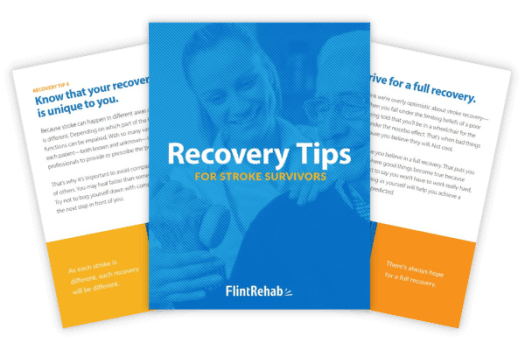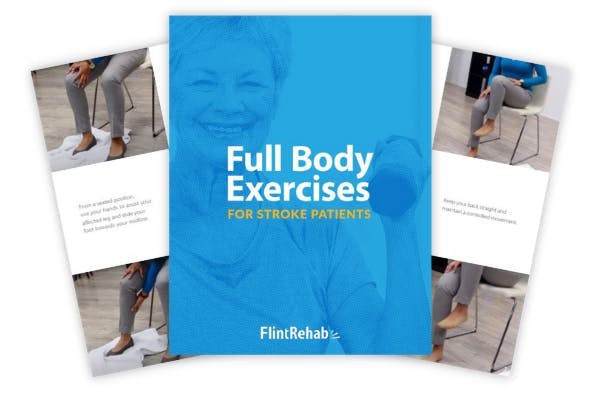No products in the cart.
No products in the cart.
No products in the cart.
No products in the cart.
Home » Neurological Recovery Blog » Stroke » Parietal Lobe Stroke: Understanding the Secondary Effects & Recovery Journey
Last updated on August 15, 2023

A parietal lobe stroke can affect the brain’s ability to interpret sensory information and spatial awareness. As a result, survivors of a stroke in the parietal lobe often struggle with piecing together their experiences, among other things.
To help you better understand parietal lobe stroke, this article will explain the causes, secondary effects, and treatment options. Although every stroke is different, we hope this guide helps paint a picture of what the road to recovery may look like after parietal lobe stroke.
The parietal lobe is located in the middle of the cerebral cortex, sitting directly behind the frontal lobe. The parietal lobe houses the somatosensory cortex, which interprets important sensations such as pain, touch, vibration, and proprioception (position awareness).
A stroke in the parietal lobe occurs when a blood vessel that supplies this lobe is obstructed by a blood clot (an ischemic stroke) or the blood vessel bursts (a hemorrhagic stroke). In cases of parietal lobe stroke, tissue damage is often caused by obstruction of the anterior cerebral artery (ACA) or middle cerebral artery (MCA), which are the main arteries that supply this lobe of the brain.
Oxygen fuels cell activity and without enough blood supply, brain cells will start to die. As a result of impaired blood flow due to stroke, the parietal lobe will begin to lose function. In cases of ischemic stroke, a drug known as tPA (tissue plasminogen activator) can be administered within the first few hours of the stroke. This drug helps to dissolve the clot and restore blood flow to the brain.
This is why immediate medical attention is essential for minimizing tissue damage and reducing the secondary effects of stroke. Knowing the warning signs of stroke can help you identify when you or a loved one are experiencing stroke symptoms and get emergency help.
Like most other areas of the brain affected by stroke, the parietal lobe is split into two halves that control different functions. In the next section, we will discuss the possible secondary effects of parietal lobe stroke based on the hemisphere affected.
A parietal lobe stroke will primarily affect sensory interpretation and spatial awareness. However, the effects of the stroke will greatly depend upon the side of the brain where the stroke occurs. This is because the brain is divided into two main halves, or hemispheres, and both hemispheres are responsible for slightly different functions.
For example, motor functions coming from the left hemisphere affect the right side of the body, and vice versa. This is the same for specific lobes of the brain, such as the parietal lobe. This means the functions of the left parietal lobe are somewhat different from the functions of the right.
Since the brain is divided into these halves, survivors can expect different outcomes following parietal lobe stroke depending on which hemisphere the stroke occurred in. Additionally, every stroke will look different as everyone’s brain is uniquely wired.
However, it’s also important to understand that these outcomes are not limited to just one part of the brain. Many functions require both hemispheres and multiple areas of the brain to work together.
To begin these sections, it is again important to keep in mind that everyone’s brain is unique. This means the location of certain functions within the brain can vary from person to person. However, there are generalizations about the left and right parietal lobes that are true in many cases.
When a survivor is affected by stroke in the left parietal lobe, the following secondary effects may occur:
When the left parietal lobe is affected by stroke, survivors are often affected by Gerstmann’s Syndrome. This is characterized by the triad of agnosia, agraphia, and acalculia.
In many individuals, the parietal lobe in the right hemisphere is more responsible for functions relating to spatial awareness and perception. Therefore, a survivor of right parietal lobe stroke may experience different symptoms such as:
While we’ve discussed the secondary effects of left and right parietal lobe stroke individually, it is important to remember that some injuries can affect both lobes. This can lead to further changes in memory or Balint’s Syndrome, which causes changes in visual processing and gaze among other symptoms.
Many secondary effects of parietal lobe stroke can be managed through a combination of different rehabilitation interventions. Parietal lobe stroke doesn’t necessarily alter the function of your senses, but rather the way they are processed by the brain. For this reason, each survivor will need to find the treatment approach that best meets their unique needs and goals.
By promoting neuroplasticity, the brain can be trained to rewire itself and relearn how to process and understand sensory information. This process can be optimized by performing high repetition of therapy exercises consistently. This allows new connections to be created in healthy areas of the brain to improve function and independence after stroke.
It is important to work closely with your rehab team after stroke. In addition to your doctors, your team will likely consist of physical therapists, occupational therapists, and speech therapists. Together they can help address your specific symptoms and provide you with the tools to work toward your goals.
A lack of spatial awareness can make it difficult for stroke survivors to interact with their environment. For example, when someone reaches for a shirt and their aim is entirely off, this can make dressing difficult and frustrating.
An occupational therapist is specially trained to help stroke survivors practice engaging their senses to carry out activities of daily living. They can assist you with activities of daily living, such as bathing or meal preparation, as well as exercises to improve fine motor skills and sensation. You have to train your brain to recalibrate coordination between your vision and touch with lots of repetition.
Stroke survivors that are experiencing difficulties with writing, reading, speaking, comprehension, visual processing, or memory can benefit from speech therapy. A speech-language pathologist, or speech therapist, is trained to help survivors recover their communication skills or adapt using compensatory strategies.
The more you perform your speech exercises consistently, the better you will get at articulating and expressing your thoughts after parietal lobe stroke. Additionally, a speech therapist can help give you strategies for activities of daily living that require communication with others.
Physical therapy is an important piece of the rehab puzzle for survivors of all different kinds of stroke. While a parietal lobe stroke primarily results in sensory changes, a physical therapist can provide exercises that address body awareness and balance. This can specifically help survivors who experience impaired proprioception.
Additionally, your physical therapist is a great resource if you are affected by hemineglect. A PT can provide you with exercises to improve your awareness of your neglected side to improve your safety and independence. The more consistently you practice your rehab exercises, the more your brain will be able to rewire neural connections through neuroplasticity.
Visual scanning exercises (such as word searches or seek-and-find) can encourage survivors of parietal lobe stroke to improve awareness of the neglected side. The more you practice engaging your neglected side, the better your brain will get at noticing stimuli.
With enough repetition, the brain can rewire itself to acknowledge your neglected side. Both occupational therapists and speech-language pathologists may use this type of exercise in their treatments to help improve your vision and attention after stroke.
After a stroke, a survivor experiences many changes in their daily life. These changes can lead to frustration due to the difficulty survivors may experience when performing once simple tasks. For these reasons, psychological care after parietal lobe stroke can be a helpful resource for both survivors and caregivers.
In addition to addressing conditions like anxiety or depression that can occur after stroke, psychological care can help patients cope with the grief that can accompany this major life change. Additionally, a psychologist or other mental healthcare provider may be able to offer strategies to address behavior or personality changes after stroke.
Parietal lobe stroke can be accompanied by a variety of secondary effects that impact many aspects of daily life. This can include a survivor’s ability to process sensory information, understand spatial awareness, and perform math or writing tasks. This depends largely on the hemisphere of the brain that is affected, as the parietal lobe is divided into left and right halves.
Luckily, there is hope for recovery through repetitive practice of rehab exercises. When neuroplasticity is promoted, functions of the parietal lobe can be reassigned to healthier areas of the brain.
This is why it is so important to work closely with your rehabilitation team to create a recovery plan that helps you reach your own unique goals. We hope this article helped you better understand parietal lobe stroke and what survivors can do to maximize recovery.

Get our free stroke recovery ebook by signing up below! It contains 15 tips every stroke survivor and caregiver must know. You’ll also receive our weekly Monday newsletter that contains 5 articles on stroke recovery. We will never sell your email address, and we never spam. That we promise.


Do you have these 25 pages of rehab exercises?
Get a free copy of our ebook Full Body Exercises for Stroke Patients. Click here to get instant access.
“My name is Monica Davis but the person who is using the FitMi is my husband, Jerry. I first came across FitMi on Facebook. I pondered it for nearly a year. In that time, he had PT, OT and Speech therapy, as well as vision therapy.
I got a little more serious about ordering the FitMi when that all ended 7 months after his stroke. I wish I hadn’t waited to order it. He enjoys it and it is quite a workout!
He loves it when he levels up and gets WOO HOOs! It is a wonderful product! His stroke has affected his left side. Quick medical attention, therapy and FitMi have helped him tremendously!”
FitMi is like your own personal therapist encouraging you to accomplish the high repetition of exercise needed to improve.
When you beat your high score or unlock a new exercise, FitMi provides a little “woo hoo!” as auditory feedback. It’s oddly satisfying and helps motivate you to keep up the great work.
In Jerry’s photo below, you can see him with the FitMi pucks below his feet for one of the leg exercises:
Many therapists recommend using FitMi at home between outpatient therapy visits and they are amazed by how much faster patients improve when using it.
It’s no surprise why over 14,000 OTs voted for FitMi as “Best of Show” at the annual AOTA conference; and why the #1 rehabilitation hospital in America, Shirley Ryan Ability Lab, uses FitMi with their patients.
This award-winning home therapy device is the perfect way to continue recovery from home. Read more stories and reviews by clicking the button below:
Grab a free rehab exercise ebook!
Sign up to receive a free PDF ebook with recovery exercises for stroke, traumatic brain injury, or spinal cord injury below: